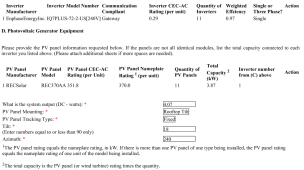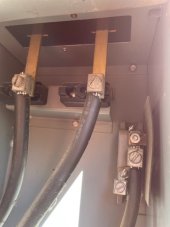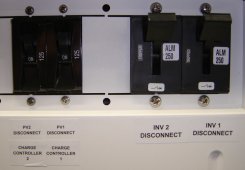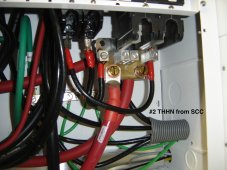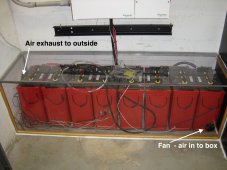GXMnow
Solar Wizard
- Joined
- Jul 17, 2020
- Messages
- 2,744
For the last few weeks I've been reading and trying to catch up through the 47 pages of this post, lots of reading. I'm preparing to add storage to my existing 4kW IQ7 solar system. Question: I seem to recall you also have about 4kW of panels, is that 16 amp limit spelled out in your NEM agreement? Oh by the way, you are really getting your system dialed in!
I do tend to ramble on a bit, but there is a lot of info in my thread, from me an several others who have chimed in. I have thought about starting a new thread about how the storage works, but I am undecided if just keeping t all here is better?
My Enphase solar is 16 x 300 watt Sil Fab panels, for a total of 4,800 DC watts. But each panel is on a basic Enphase iQ7 60 inverter, which tops out at 240 watts, or 1 amp into the 240 volt panel. That 16 panels then can top out at 16 amps, which just happens to be the NEC code 80% constant rating for a 20 amp breaker. My main panel is only a 100 amp panel, with a 100 amp main breaker, so the 120% rule allowed, a 20 amp back feed breaker. Amazing how that all worked out. So my NEM 2.0 agreement with So Cal Edison, and the approved plans with the City of Santa Clarita both state "System equipped with a 20 amp back feed breaker, not to exceed 16 amps of continuous current". And the So Cal Edison agreement also adds "Maximum monthly energy export not to exceed 900 KWHs total". On the best days, my system can just top over 30 KWHs, so 30 days x 30 KWHs = 900 KWHs in a month. Basically, they set that limit if my house didn't use any power and it all exported.
My absolute minimum base load I ever see in my house is over 600 watts. So I could certainly add 600 watts of solar, and I would still never hit the 16 amp export limit. But I want to add 2,000 watts. In the hot summer, this should never be a problem. I have not been able to top up my battery for over a week. The air conditioner is just using too much power. Not only does it deplete the battery each night, some nights before 9 pm even, it uses a lot of power when the sun is shining, and that is taking power that could be charging the batteries. As it is, I only have it drop the charge rate to 5% (7 amps) so the battery is still charging a little, but I have to buy some grid power when that happens. Yesterday, during the 2pm to 3pm hour, With the sun just past solar noon, the battery was charging at 7 amps (at 53 volts = about 400 watts), The air conditioner was running at high output, pulling 14 amps x 240 volts = 3,360 watts, The blower in the furnace pulls another 7 amps at 120 volts = 840 watts. The rest of the house loads looks to have been around 850 watts. The solar was cranking out 3,400 watts AC into my backup loads panel.
So I get loads totaling 400 + 3,360 + 840 + 850 = 5,450 watts - 3,400 watts = 2,050 watts I was buying from So Cal Edison. The A/C did run the entire hour, so I bought just over 1.8 KWH for that one full hour. Without the solar panels or battery, I would have had to buy about 5,000 watts or 5 KWHs. So my existing solar can handle 60% of my load at that time. Adding the extra 2,000 watts of solar, should almost zero it out. And I will still not be exporting any power. When the A/C cycles off, it will just charge the batteries faster.
The only problem is when I have great solar production days when it is cool and I don't have the A/C running for over 4 hours. If the solar panels produce enough to top out the batteries before 4 pm, the solar export could exceed my 16 amp limit caused by the 20 amp back feed breaker limit.
Ideally, I should downgrade the main breaker to an 80 amp, and then I could run a 40 amp back feed breaker. But I would also then have to have the system permitted and inspected again. Not the end of the world, but I also don't wan them to change the terms of my NEM deal either. SO my thoughts are to have a way for my PLC to just turn off a few of the new panels if my export current starts going too high. Another option is turning on dump loads, like electric water heater elements, or commanding the A/C to start. I might even be able to have it fire up my air compressor and top up the tank on the extra solar power. Another option is having the new added panels be DC coupled to charge the battery bank. Once it is full, they just will hold the voltage steady and reduce their power output, but this is wasting some power that I could be exporting 95% of the time. Even with 2,000 watts of additional panels, it will be rare to see my system able to export the full 16 amps. Let's try a little math experiment.
Back in May, I had my best production days, with cool air. On May 11, 2022 the battery bank was completely topped out before 1 pm. The solar panels maxed out the 240 watt inverters from 11:30 am to 3:15 pm pushing about 3,900 watts the whole time. So Cal Edison shows my house was exporting 2,990 watts for the 2pm to 3pm hour. So the house was using my expected 910 watts or so. So If... I had 6,800 watts of panels, instead of my current 4,800 watts, and assumed the production could hit the same target, what does that look like? I can export 16 amps x 240 volts = 3,840 watts. And I need another 900 to run the house = 4,740 watts. 4,740 / 6,800 = 70% of the solar panel production. On this great production day, when did my panels make more than 70% of rated power? 4,800 x 0.70 = 3,360 watts. Looking at the plot, my system made over 3,300 watts from 10:30 am to 4:00 pm. So if my battery is not charging, between those times, I may have to turn off some panels. If I go with 5 x 400 watt panels, I can leave 2 on all the time. But the other 3 may have to turn off once the battery is full, if I don't have enough load on in the house. That is doable. I want to do the disconnect on the DC side, so the Enphase data still sees the panel as there, but not producing. Then the data log will show how much production I am curtailing off. I think I would do it with 2 relays. One will turn off just one panel, and the other turns off two panels. Then my PLC can decide if I need to drop 400, 800, or 1,200 watts of panels. The scan rate on the PLC now could see the current go too high and make the choice in under 10 seconds every time. I could make it even faster if need be. And I can make it predict a little early to be on the safe side. The other benefit os switching the DC side into the Enphase inverter is that there will not be the 5 minute delay. It will just think a bad cloud went over.



